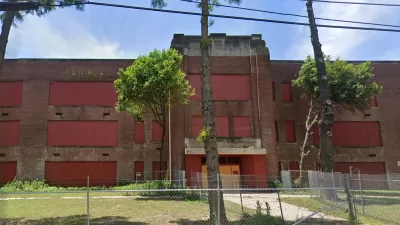What was meant to be an icon for the city of Memphis has become a burden, as the city's pyramid-shaped sports and concert complex sits vacant and unused. The city is still trying to find a way to reuse it.
"Holy Moses! The Great American Pyramid of Memphis."
"A glorious structure of poured concrete and shiny stainless steel, of form if not function, it rose 321 feet from the sedimentary banks of the Mississippi River, just an ibis's glide from Interstate 40 and the Hernando de Soto Bridge. Nothing quite like this existed anywhere else on the continent, save the exotic metropolis of Vegas."
"A quarter-century ago, the idea of a pyramid arose from the city's desire to provide a larger venue for sporting events and concerts, and to have a structure as defining as the Gateway Arch in St. Louis, 300 miles upriver. Along came Sidney Shlenker, a Denver businessman and visionary, to promote a pyramid of pyramids, one befitting a city named after the ancient Egyptian capital."
"By the time the $68 million arena opened in November 1991, the city and Shelby County had fired Mr. Shlenker for failing to come up with his share of the project's cost. The Great American Pyramid of Memphis became, simply, the Pyramid: a place with 150,000 square feet of unused space and a never-assembled inclinator somewhere in its cavernous hold."
FULL STORY: A City’s Horizon, Reshaped by an Empty Promise

Planetizen Federal Action Tracker
A weekly monitor of how Trump’s orders and actions are impacting planners and planning in America.

Maui's Vacation Rental Debate Turns Ugly
Verbal attacks, misinformation campaigns and fistfights plague a high-stakes debate to convert thousands of vacation rentals into long-term housing.

Restaurant Patios Were a Pandemic Win — Why Were They so Hard to Keep?
Social distancing requirements and changes in travel patterns prompted cities to pilot new uses for street and sidewalk space. Then it got complicated.

In California Battle of Housing vs. Environment, Housing Just Won
A new state law significantly limits the power of CEQA, an environmental review law that served as a powerful tool for blocking new development.

Boulder Eliminates Parking Minimums Citywide
Officials estimate the cost of building a single underground parking space at up to $100,000.

Orange County, Florida Adopts Largest US “Sprawl Repair” Code
The ‘Orange Code’ seeks to rectify decades of sprawl-inducing, car-oriented development.
Urban Design for Planners 1: Software Tools
This six-course series explores essential urban design concepts using open source software and equips planners with the tools they need to participate fully in the urban design process.
Planning for Universal Design
Learn the tools for implementing Universal Design in planning regulations.
Heyer Gruel & Associates PA
JM Goldson LLC
Custer County Colorado
City of Camden Redevelopment Agency
City of Astoria
Transportation Research & Education Center (TREC) at Portland State University
Jefferson Parish Government
Camden Redevelopment Agency
City of Claremont





























